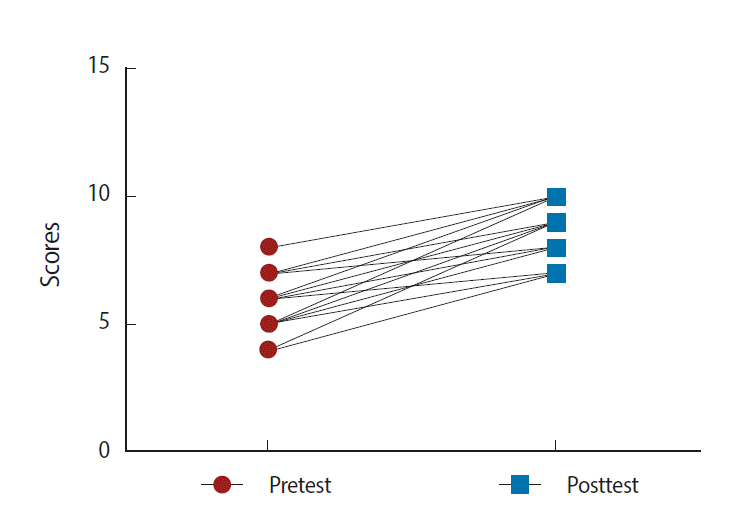J Educ Eval Health Prof.
2013;10:9.
Learning gain of pharmacy students after introducing guided inquiry learning with computer simulation in a pharmacology class in Fiji
- Affiliations
-
- 1Department of Health Science, College of Medicine, Nursing and Health Sciences, Fiji National University, Suva, Fiji. christian40ezeala@yahoo.com
Abstract
- PURPOSE
Active learning methods such as problem-based learning have been widely adopted in health professions education, although guided inquiry learning has been used only in limited settings. The objective of this study was to determine students' learning gain when guided inquiry learning was combined with computer simulation in a basic pharmacology course.
METHODS
The second-year pharmacy students from Fiji National University participated in the study. Following classroom lectures on pharmacokinetics and pharmacodynamics, the students used tutor-prepared practice problems in groups of 3-4 to explore their concepts with Cyber Patient and Virtual Organ Bath software. Pre- and posttest assessments were administered to determine the learning gain from the exercises based on Hake's criteria.
RESULTS
Forty-two students participated in the study. The average normalized learning gain from the pharmacokinetics exercises was 0.68. Thirty-seven participants (88.1%) achieved a significant learning gain, while 5 (11.90%) did not. The average normalized learning gain from the pharmacodynamics exercises was 0.76. Forty-one participants (97.6%) achieved a significant learning gain, while one participant (2.4%) did not.
CONCLUSION
These results demonstrated that use of guided inquiry learning with computer simulations could produce significant learning gains with improvement in students' understanding of basic pharmacology.
MeSH Terms
Figure
Reference
-
1. Stewart DW, Brown SD, Clavier CW, Wyatt J. Active-learning processes used in US pharmacy education. Am J Pharm Educ. 2011; 75:68. http://dx.doi.org/10.5688/ajpe75468.
Article2. Abraham MR, Renner JW. The sequence of learning cycle activities in high school chemistry. J Res Sci Teach. 1986; 23:121–143. http://dx.doi.org/10.1002/tea.3660230205.
Article3. Colt HG, Davoudi M, Murgu S, Zamanian Rohani N. Measuring learning gain during a one day introductory bronchoscopy course. Surg Endosc. 2011; 25:207–216. http://dx.doi.org/10.1007/s00464-010-1161-4.4. Hake RR. Interactive-engagement versus traditional methods: a six-thousand-student survey of mechanics test data for introductory physics courses. Am J Phys. 1998; 66:64–74. http://dx.doi.org/10.1119/1.18809.
Article5. Kwan CY. Problem-based learning and teaching of medical pharmacology. Naunyn Schmiedebergs Arch Pharmacol. 2002; 366:10–17. http://dx.doi.org/10.1007/s00210-002-0561-y.
Article6. Persky AM. Multi-faceted approach to improve learning in pharmacokinetics. Am J Pharm Educ. 2008; 72:36. http://www.ncbi.nlm.nih.gov/pmc/articles/PMC2384211/.
Article7. Premkumar K, Coupal C. Rules of engagement-12 tips for successful use of “clickers” in the classroom. Med Teach. 2008; 30:146–149. http://dx.doi.org/10.1080/01421590801965111.
Article8. Alliger GM, Janak EA. Kirkpatrick’s levels of training criteria: thirty years later . Pers Psychol. 1989; 42:331–342. http://dx.doi.org/10.1111/j.1744-6570.1989.tb00661.x.
Article9. Blanchard PN, Thacker JW, Way SA. Training evaluation: perspectives and evidence from Canada. Int J Train Dev. 2000; 4:295–304. http://dx.doi.org/10.1111/1468-2419.00115.
Article
- Full Text Links
- Actions
-
Cited
- CITED
-
- Close
- Share
- Similar articles
-
- Integration of computer-simulated practical exercises into undergraduate medical pharmacology education at Mulungushi University, Zambia
- Metacognition, Learning Flow and Problem Solving Ability in Nursing Simulation Learning
- Effects of Problem-Based Learning Combined with Simulation on the Basic Nursing Competency of Nursing Students
- Effects of Blended Learning on Pharmacy Student Learning Satisfaction and Learning Platform Preferences in a Team-based Learning Pharmacy Experiential Course: A Pilot Study
- The pharmacology course for preclinical students using team-based learning



